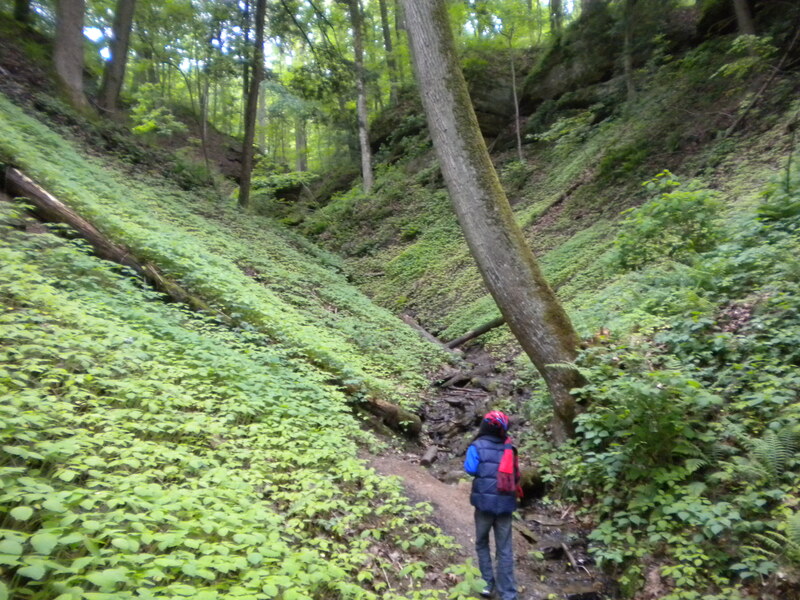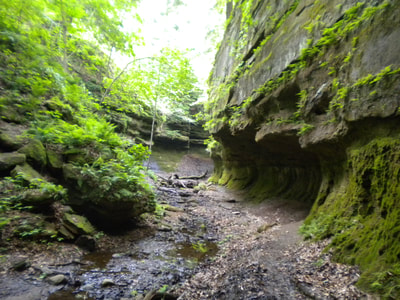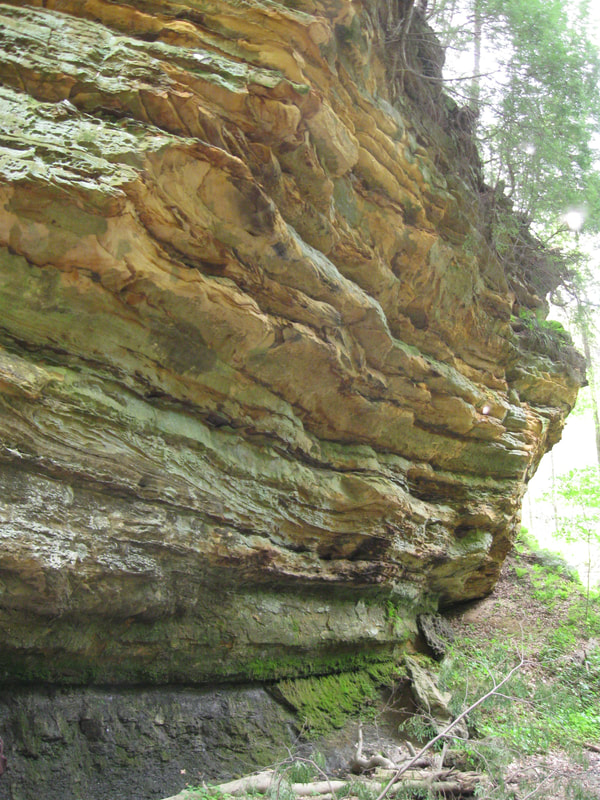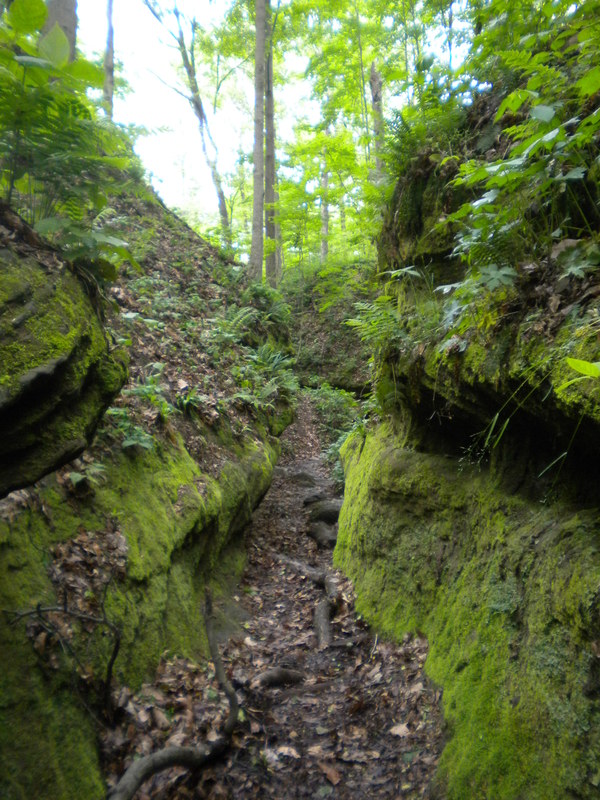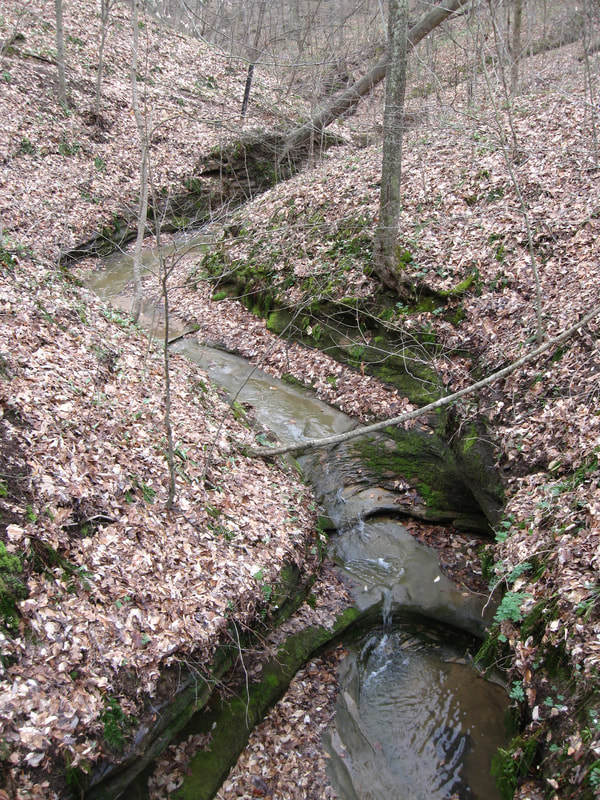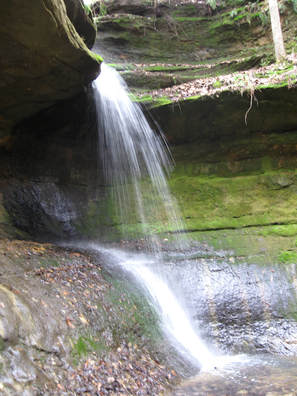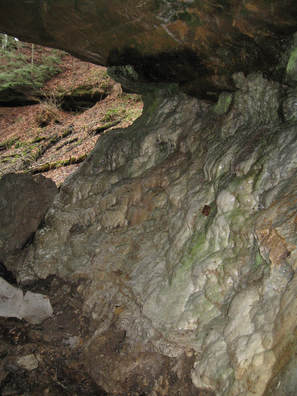Where a river has trenched 200 feet (60 m) down below the surface of a flat plain, tiny tributary streams have cut steep, 'V'-shaped ravines, partly in soil and partly in sandstone and siltstone bedrock. Although hillslopes of any kind are rare in this region, and usually far from dangerous, this particular woodland hides steep drop-offs and cliff edges where a misplaced step can lead to disaster. The ravine floors provide sheltered, mostly gentle and safe descents from the flat upland to the river’s edge.
Dimensions The ravines are tens of feet (a number of meters) deep, exceeding a hundred feet (30 m) near their junction with the river. They are about a quarter mile (half kilometer) in length.
Key Details
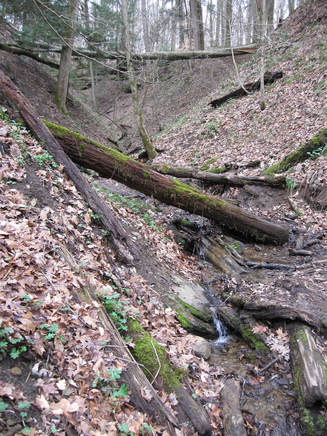
- In many places nearer the river, the ravine floor is no wider than the creek bed - only a few feet (1-2 m) across, bounded by steeply angled, soil-covered slopes that would take considerable exertion to climb or traverse along. Walking in the stream bed (normally just shallow pools and rivulets of flowing water) is often the safest and fastest choice, despite patches of mud and accumulated fallen leaves. There are many small boulders sitting in the creek, and some fallen logs on the ravine floor to scramble over.
- Upper sections of the ravine, further from the river, are bounded on one or both sides by vertical sandstone cliffs. The ravine floor here is broader, with the creek meandering back and forth on mucky, black soil and collapsed rock piles. The cliffs have many overhanging ledges between more deeply recessed levels. These could present a challenge to a rock climber, especially because the weathered rock is crumbly in places and some ledge rims are covered with loose sand.
- Progressing even further upstream, sections of the ravines become narrow, winding clefts a few feet wide, with water-sculpted sandstone walls and floors. Angled soil slopes are not far above, but in some places the close rock walls at creek level can provide cover from observers on tops of the slopes, and can also limit the view upward for persons traveling the creek bed. This would be an especially bad place to be caught by high water from a sudden storm. However on dryer days, because the sandstone is so porous, the creek bed is often entirely dry.
- At the most upstream tips of the ravines, there remain distinct breaks in slope marking the edges of the shallow trenches. In very heavy rains, these minor channel-ways can gather considerable flows of water from the clayey soil surface of the surrounding forest floor.
- In warm months, many portions of the ravine side slopes are lush with ferns. Lower, moister portions of the sandstone walls are covered with bright moss.
- Once or twice along the path of any ravine, the creek drops over a rock ledge in a waterfall 3-20 feet (1-7 m) high. (This often marks a transition in the valley form, with sloping soil slopes covering siltstone below the waterfall, and exposed sandstone cliffs above.) The rock wall below the waterfall rim may be a smooth slide leading to a shallow plunge pool, but more commonly it is deeply recessed, with the water coming over a significant ledge that shelters an alcove below. The alcove walls are often shiny with weeping moisture, covered with a mix of moss and smooth travertine-like mineral deposits. (The upper layer of sandstone easily soaks up water, but the siltstone bedrock below repels it, so much water that has seeped underground in the ravine above re-emerges here.) When traveling up or down past a large waterfall, a difficult traverse on the ravine wall is often necessary to bypass the· steep drop.
- Hollowed-out alcoves and bedrock seepage faces also appear in a few places along side walls of ravines.
Story Elements
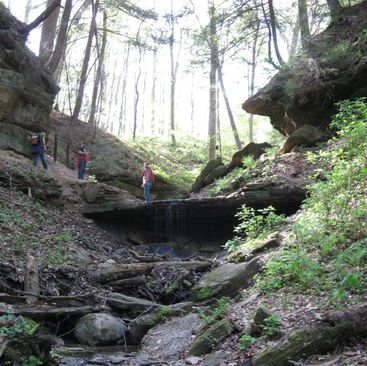
- Many spots on the ravine floors provide hidden meeting places, opportunities for private reflection, and difficult sites for hostage situations.
- Broader parts of the ravine floors offer campsites with shelter from winds above, and readily accessible water.
- Trickling waterfalls curtain recesses below, evoking sacred grottos or portals. More practically, the recess under a waterfall ledge provides a hiding place from observers upstream or on the slopes.
- Someone may appear quite suddenly, walking around a bend on a narrow ravine floor.
- A message might be carved in the soft sandstone with a knife or nail.
- This would be a great environment for fantastic creatures of tree or stone. Creatures craving moisture might be attracted to the weeping, mossy rock walls below ledges.
- Mist may rise from river level to fill lower portions of ravines, or flow down them in cold-air currents descending from higher ground in variable weather.
- Rising water, or pursuers converging from the upper and lower ravine, may force characters to scale the side walls.
- Ledges on the sandstone cliffs provide precarious hiding places for people, and the accumulated sand there may hold partly-buried valuables or other clues.
- Lush vegetation in ravines, on steep ground less attractive for farming or timber-cutting, may draw some particular characters to this area, shunning society or dedicated to protect these unspoiled bits of nature.
- Combat Dynamics:
- Sudden drop-offs at edges of the flat upland surface present danger, but also the opportunity to quickly disappear from sight.
- Ravines and promontories overlooking the main river valley make the top edge of the flat upland surface a more complex, lengthy boundary line to defend, compared to the relatively straight line of the river’s edge.
- Choke points in confined stream passages, especially above waterfalls, allow little space to stand side-by-side, and less space to swing large weapons.
Reference Location
Shades State Park, west-central Indiana. (In the 19th Century this site was named “The Shades of Death” due to the deep ravines and dimness of the light allowed through by mature forest cover overhead.)
© Rice-Snows 2017
Proudly powered by Weebly
